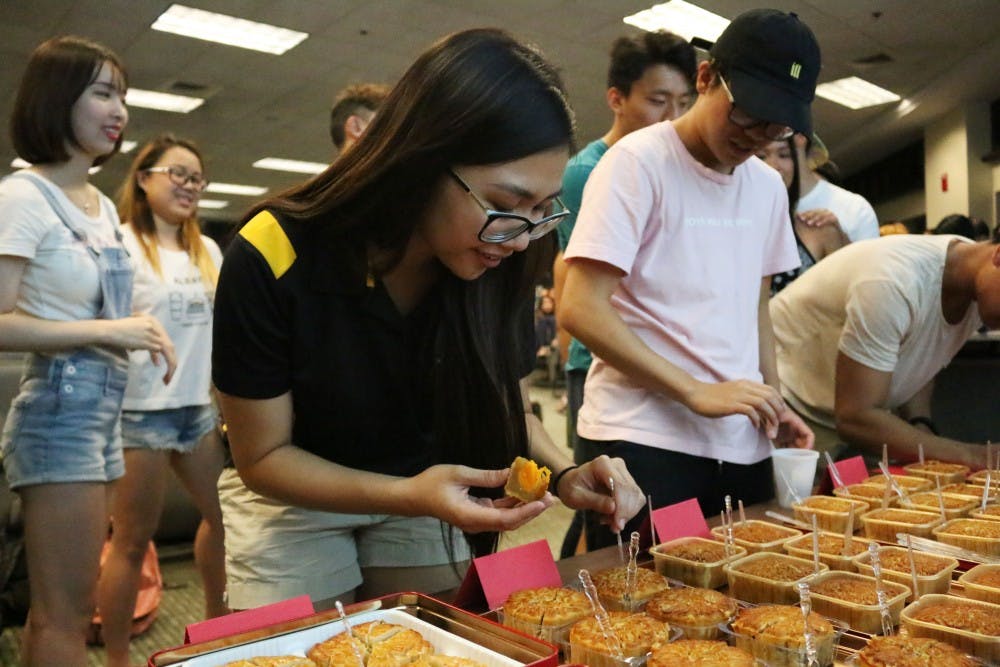On the eve of the brightest, fullest moon of the year, families across Asia gather together to celebrate an age old tradition: the Mid-Autumn Festival.
While sipping authentic Chinese tea, eating moon cakes, making red lanterns and building friendships, members of the Chinese Undergraduate Student Association (CHUSA) brought the event to the Tempe campus on Aug. 13.
Mid-Autumn Festival makes students feel at home from The State Press on Vimeo. Video by Madi Margolis.
The Mid-Autumn Festival was originally a time for ancient Chinese emperors and families to take a break from work or school in order to worship and appreciate the moon in hopes it would bring them a successful harvest in the next year.
The sacrifice and appreciation of the moon dates back to the Tang Dynasty, A.D. 618-907, where the first steps toward the Mid-Autumn Festival were created. The event started expanding during the Northern Song Dynasty and, in the Ming and Qing dynasties, A.D. 1368-1912, the event turned into a large-scale festival as popular as the Chinese New Year.
The event is still widely celebrated across Asia today.
CHUSA president Catalina Lee, a supply chain management and marketing junior, said she thinks the event is special because it symbolizes families coming together and reuniting.
The festival happens annually on the 15th day of the eighth lunar month. Families typically gather together to eat food and enjoy each other’s company. However, being at the University as an out-of-state or international students can make it difficult to be with family on this day, Lee said.
“We think that in terms of celebrations and holidays, it’s really important to try and bring together as many people as possible,” she said.
Lee invited other Asian/Asian Pacific American Student Coalition organizations such as, the Philippine American Student Association and the Hawaiian Pacific Islander Club, in order to strengthen bonds between organizations and give students a home at ASU.
“(Students) are really able to find their home away from home within each of those individual clubs, whether they’re domestic students or international students who relate on a cultural background," she said. “Then, all together (they) celebrate on a full scale and really just get to know people and build this Asian Pacific American community, thus really making it a strengthened bond.”
Zhaohan Wang, a business law senior and international student who moved to Arizona from China three years ago, doesn’t have the opportunity to spend this holiday with his family. He said his family always celebrated the festival back home, and the day is special to him.
“The Mid-Autumn Festival is important because it’s a family unit thing, so all the family members get together and celebrate,” Wang said. “It’s nice to be here, talk to people and make new friends. It makes the homesick go away.”
A traditional Mid-Autumn Festival has a variety of different traditions that are followed such as eating moon cakes, making red lanterns, appreciating/worshipping the moon, lion dances and much more. For this event, the CHUSA executive board decided to stick to the simpler traditions like eating moon cakes, making red lanterns and drinking tea.
A large majority of the students at the event said the moon cakes are the most exciting part of the tradition. The cakes are only offered in September and October, making it a special treat for families to look forward to when the festival comes around.
In the 13th century the Mongols invaded China, taking over and ruling with an iron fist. Under the leadership of Zhu Yuanzhang, Liu Bowen staged a rebellion to happen on the day of the Mid-Autumn Festival. In order to get the word out without the Mongols knowing, Bowen hid secret messages inside the moon cakes. The rebellion succeeded and moon cakes have been eaten ever since.
Members of the community also got the chance to make their own red lanterns, which Lee refers to as “lucky red lanterns.”
“Red is the luck color of China, and we wanted people to be able to have a physical embodiment of luck for them and for the rest of their school year,” Lee said.
CHUSA’s main goal of the event is to strengthen their community, create friendships with one another and make students, especially international students, feel like they a have place in the Sun Devil community.
“It’s a really interesting culture to dive into, especially since our ASU student body is very diverse in the way that we have a lot of Chinese international students," Bailey Cadelina, supply chain management junior and public relations chair for CHUSA said. "It’s a really good way to have everybody come together and share a meal together.”
Reach the reporter at bmchugh4@asu.edu or follow @blakelymchugh on Twitter.
Like The State Press on Facebook and follow @statepress on Twitter.




